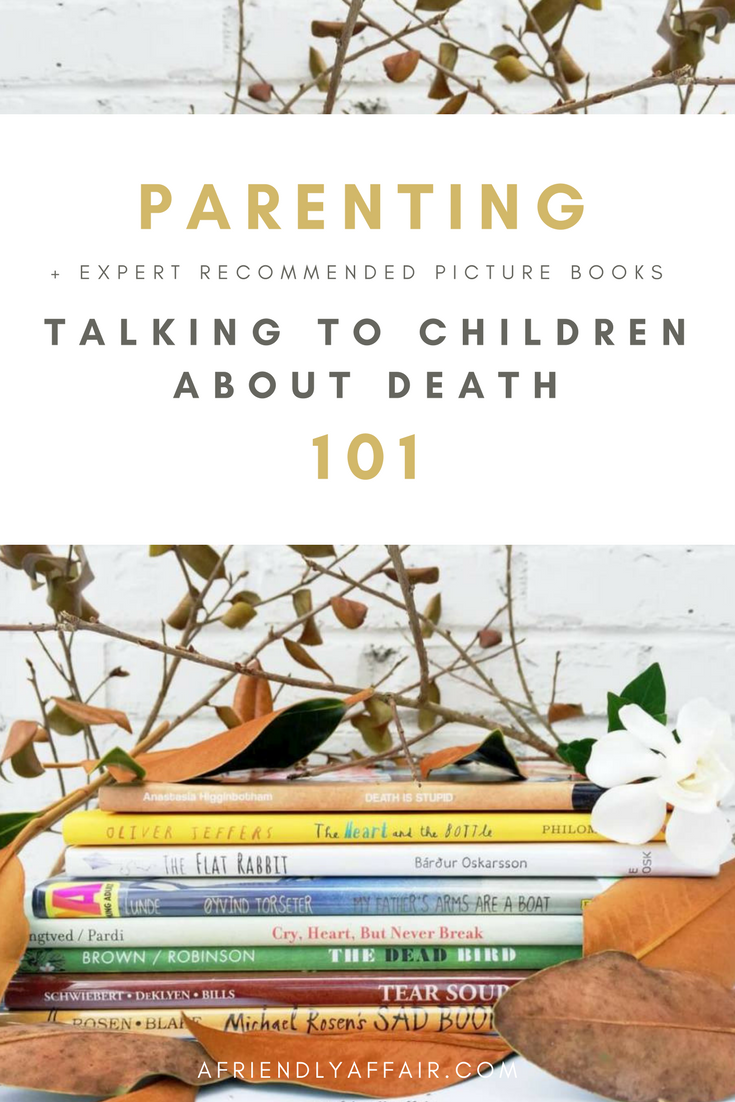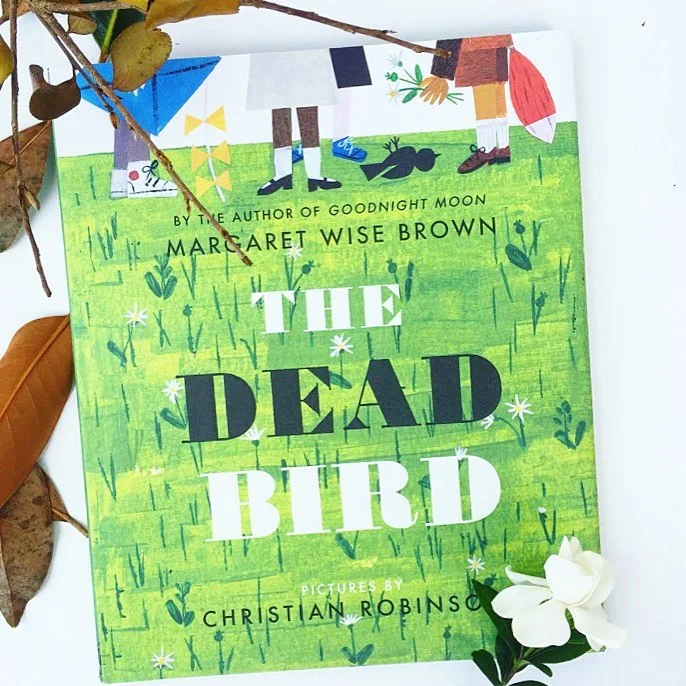How to Talk to Your Kids About Death
Although we may wish to save our children from pain and peril, there are limits to what we can do.
Unfortunately, no matter how hard we may try to avoid it, our children will learn about Death. But luckily for parents who are feeling lost and without a guide, kid’s picture books are an absolutely brilliant and rich source of guidance. In a series of @afriendlyaffair Instagram posts, I considered how to talk “grief, loss, and mourning” to children using these beautiful little guideposts.
This post is a roundup of that expert insta-advice.
Hopefully you will find something to help you feel comfortable talking and bearing witness to the grief of a child. Because major loss is a life-long, mutable process, the books and wisdom are divided according to developmental stage. So after the jump, toward the bottom of the post, you should find a list of each book reviewed, along with the developmental stage for which that book is appropriate. When you click on the link, you can expect a review of the book, a brief discussion of the developmental stage (pre-school, elementary, etc) for which the book is appropriate, and tips for using the book to explore and engage the unique grief of a child that age. I will be adding them to this post as they become available.
There are only a few things I can say that could be considered universal. So much of our response depends on age, experiences, our beliefs, & the circumstances. Finding a dead animal at 2yo is different from losing a grandparent at 12yo, which is different from losing a parent at 8. I think it might help though, if we try to articulate a shared foundation.
So lets all agree on a few things:
- Death is not a four letter word. It is a reality
- What hurts us cannot always be kissed and made better
- Grief is a skill (not a stage) that needs to be taught with openness, curiosity, and patience.
- All children learn about death, some earlier, some later, some easier, some with great pain.
- The best place for children to get their questions answered about death is in the home, in the context of a loving relationship.
The Dead Bird, by Margaret Wise Brown, is stark and to the point. To the adult heart, with its existential and sentimental concerns, this book is startling. It opens: “The bird was dead when the children found it.… there was no heart beating. That was how they knew it was dead.” Then later the children muse, “… That was the way animals got when they had been dead for some time – cold dead and stone still with no heart beating.” After I read it the first time, I reached out to friends and fellow book lovers, “How could this book be?” I complained. I had such high hopes; the art was so lively and lovely. I felt the text was plain and inconsiderate. Lost in my own adult-ish needs for the dead to be cozy in the great beyond, it was painful to read things like “cold” and “stiff” – descriptors Brown doesn’t bother to soften. But then I started thinking developmentally. I considered the concrete and literal nature of the 2-4 year old, and I realized that this book is actually, totally…brilliant.
Here is why:
Children 2- 4 years old, don’t understand “forever.” For them, death is reversible, temporary, and impersonal. Children this age are a threat to “kill” something because they don’t understand the irreversibly of death at all. The Dead Bird takes this task head on. Without mincing words or introducing concepts for which the child does not yet have a framework, Brown stays grounded in the moment. This bird is dead, this bird is warm but will get cold, this bird is going in the ground. This bird will not come out of the ground. We forget this bird and go about our play, and the bird will still be there, in the ground, where we left it. The genius of this book is not in the way it simplifies expansive concepts, but in the way it sheds all of that to communicate one thing simply: Death is final.
My Father’s Arms are a Boat
by Stein Eric Lunde // Ages: 4 - 18
Grief operates on several different levels. At its deepest, most subconscious level, Grief is almost a sentient being, searching every relationship and every situation, looking for mutual recognition, comfort, and understanding. This grief moves quietly, sending out its tentacles, hoping to slake its thirst for a companion and a witness.
This is especially true for tweenagers and adolescents who, due to their frontal lobe immaturity, suffer thinking that they are both the center of the universe and completely misunderstood. Scientists call this ‘imaginary audience’ and ‘personal fable,’ and it is likely due to a stage brain development. While we all search for recognition in grief, teens can be almost swallowed by it. Add to this, their attitudinal issues about authority, and you have a sad mix of both needing to be comforted or seen, and rejecting directed advice and authority.
The brilliance of My Father’s Arms are a Boat, which is maybe one of the most moving books I have ever read, is in the way it completely sheds itself of any didactic or authoritative intention to simply show you a moment in time. The authors nakedly brave a simple scene, a scene that can be read and understood by nothing other than grief. Those searching tentacles will find a home - a boat - in this book. Your tweenager won't find advice or teaching, it will find simply and gently…a knowing.
From the jacket:
“In this quiet, sad, but ultimately incandescent picture book, we meet a gentle, steady father who calms his anxious son as they take care of each other during a vast winter’s night.” This father is a comfort to the child and a model for the adult reader. Good luck, reader. I am sure your grief will find a piece of what it hopes in this book.
Cry, Heart, but Never Break
by Glenn Ringtved // Ages: 7 - 10
“What would life be worth if there were no death? Who would enjoy the sun if it never rained? Who would yearn for day if there were no night?”
Children this age will typically personify death, and of all the picture books with death personified, this is my absolute favorite (it is also the most developmentally appropriate/relevant). Around age 7 kids start to understand that death is final. Consequently the inescapability, especially for their loved ones, has become the featured hurtle and fear. Who remembers worrying over their parents’ commute or health?
In this book, death is personified as understanding and wise. I believe that his nature and stories, as he patiently helps these young children come to terms with their grandmother’s imminent passing, will be supremely comforting. The added bonus, which is actually the beautifully featured take away for adults, is the reminder to have integrated appreciations. Yin and Yang, death and life, sorrow and delight, grief and joy, all live in a delicate balance that propel us toward fulfillment.
Life and I
By Elisabeth Helland Larsen // Ages: 3- 10
Life and I is a book about Death. Big, beautiful, heart on her sleeve, and flowers in her hair, Death.
It has been said that there are only three things we can do about death: desire it, fear it, or ignore it. But that isn’t true, is it? We can hate it. We can harbor a resentment so deep and fertile that we refuse to even recognize the pain caused by grief in those around us. Perhaps desperate for redemption and convicted of Eternity, we say that death doesn’t matter. Or cold from heartbreak, we tell our friends (and ourselves) that it is life that doesn’t matter. Both attitudes, spring from a wretched unforgiveness.
What I loved about Death and I, was not the beautiful illustrations or the poetic text. It was the emotional barometer, the way this vision of death, personified as beautiful, feminine, and kind, actually surfaced my own latent hate. The first time I read it I actually repackaged it for return. I was acting out what I thought I knew, “No one is going to buy that death is a host and reluctant guide. Death doesn’t graciously make room for life, it doesn’t have our best interests in mind.”
Ultimately, if we are not moving toward forgiving death, we will never be able to tolerate the grief caused by death in our children. Buy this book and listen to your heart. Gauge yourself. Children sense what saddens you and will avoid asking necessary questions if they are afraid to upset you. Know your discomfort and address it with the child. It is reassuring to them that they are not alone in their upset, that you desire to be with them, even when you both are in pain.
“Death is hard for me. Sometimes I resent it and feel as if it has stolen from me. I cry a lot. But I want to answer your questions. I want to be here for you, even when I am sad, even if you upset me, but especially when you are sad.”
Death is Stupid
By Anastasia Higgenbotham // Ages: 5 - 12
Death is Stupid is another, straight to the point, meet-em-where-they’re-at book about death. And for talking about grief with the really young ones, true greatness is simply that: zero sentiment, only truth, no fluff and mumble. I don’t care for the word “stupid,” but I deeply appreciate the wisdom of this book, and I definitely see the value in tempering my mama-knows-best impulses. After all, grief is reactive, it says dumb things, and tolerance is key.
The main character is a child that is dealing with the loss and grappling with the confusing things adults say. The narrator stays grounded in the language and understanding of a child. I love this book for the way it shuffles right through the concerns of a child this age, while also giving him permission to be confused, angry, and sad. In the end, the child is reminded to love and remember; it’s sweet.
For kids ages 5-7 grief is a strange place, full of pain, curiosity, and confusing answers. It's hard for caregivers to deal with the heart wrenching, repetitive questions about the life and behavior of the deceased. Also, kids this age are processing the inevitability of death and working their grief out in play. Grief is unique, anger is normal, play is important. Questions fly and answers are inadequate. Accept your limitations.
Other Awesome Books about Death"
Duck, Death, and Tulip
by Wolf Erlbruch // Ages: 4 - 12
The Heart and the Bottle
by Oliver Jeffers // Ages: Preschool - 3
Ida, Always
By Caron Levis // Ages: Preschool - 3
The Invisible String
By Patrice Karst // Ages: 7 - 10
Tear Soup
By Pat Schweibert // Ages: 4 - 99







